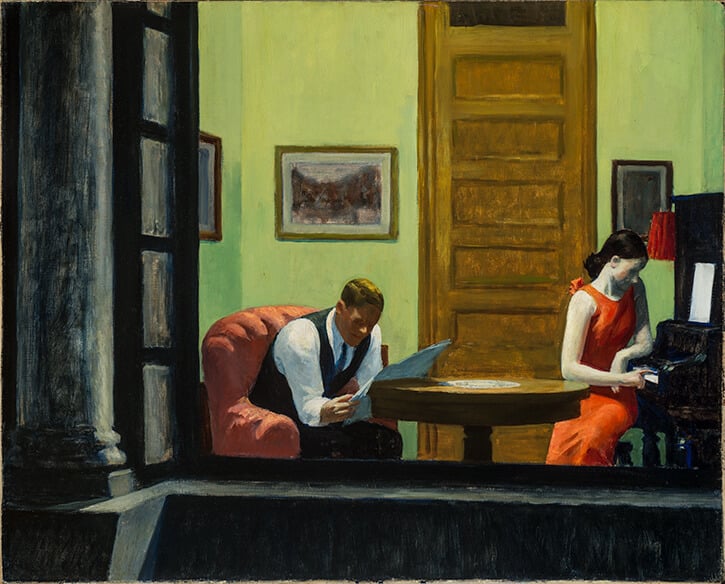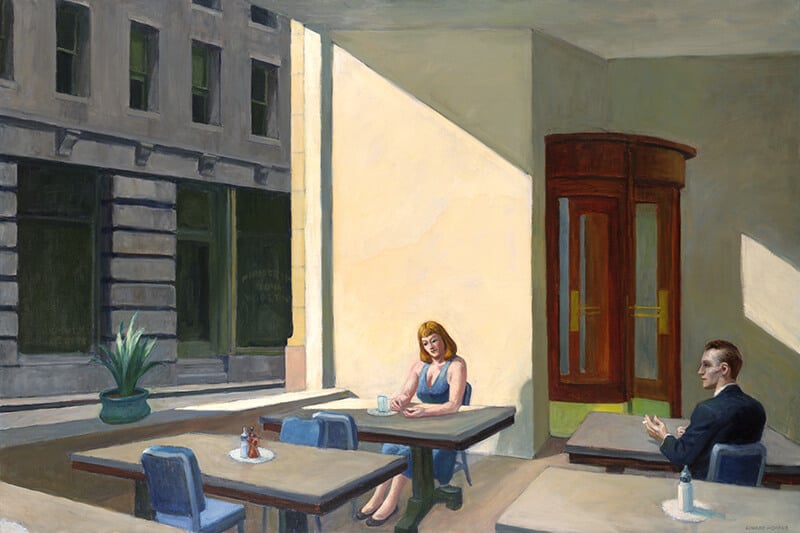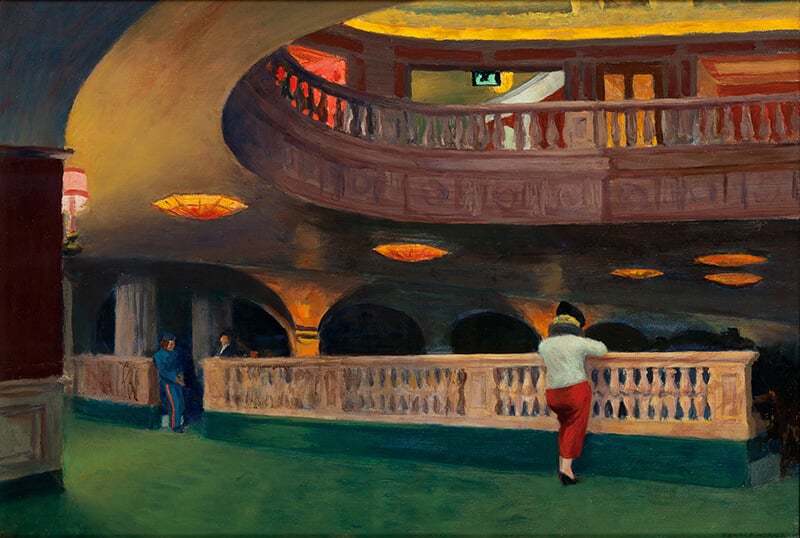Hollow City

Edward Hopper’s New York. Whitney Museum of American Art, New York, October 19, 2022–March 5, 2023.
Urban hellscapes, New York ones in particular, look more heavenly in the soft glow of hindsight. Seventies Manhattan, formerly Exhibit A for how the country was going straight to shit, is widely remembered as a wonderland, quattrocento Florence for punks. The neon-pickled, pre-Disney Times Square of Midnight Cowboy looks fresh beside the current version, and the midcentury Midtown alienation of The Apartment and Revolutionary Road rests on the kind of job security many would trade an organ for. Edward Hopper’s drawings and paintings of New York are all but synonymous with quiet desperation: the distinctly big-city feeling of being gray and alone in a loud, colorful place. But look at Nighthawks—based, Hopper said, on a restaurant on Greenwich Avenue, not far from where he lived—and tell me you don’t long for this prehistoric land where you never have to wait for a seat and distraction has yet to conquer the world.
At first, Edward Hopper’s New York, an exhibition at the Whitney Museum, a few blocks from where that restaurant once stood, seems like a straightforward case of grass-is-always-greener thinking. There’s more than a little in curator Kim Conaty’s companion essay: writing about Early Sunday Morning, Hopper’s 1930 painting of a cheerily (or is it eerily?) bright stretch of Seventh Avenue, she draws the following comparison between then and now: “The neighborhood barber shop, marked by its red, white, and blue pole and patronized by casual walk-ins, has all but been replaced by the destination salon. . . . Customers patronizing whichever generic chain pharmacy on any given corner may hardly even bother to look up from the screens in their hands.” This kind of nostalgia can be hard to resist, even if you’re fully aware that the murder rate in Seventies New York was four times the current figure—or for that matter, that a Village barber shop in the Thirties could only handle all those walk-ins because nobody had money for a haircut.
Art critics often downplay Hopper the urban realist in favor of Hopper the American, Hopper the Existentialist, or Hopper the tortured dreamer.
But it’s not only the contrast with AD 2022 that makes these places seem appealing. In taking a close look at Hopper’s art (plus his letters, journals, ticket stubs, and other ephemera), the show has teased out a point that was never exactly hidden but tends to get disregarded all the same. Hopper moved to New York City to study art in 1899 and died there in 1967. He and his wife lived in the same Washington Square apartment for nearly fifty years. He fought to save historic buildings in his neighborhood and nondescript ones, too, provided they weren’t tall. His paintings are unmatched in their evocation of urban alienation, but it never occurred to him to trade urban life for something else (judging from his paintings of New England and California, he didn’t like the rest of America any better). He was a ride-or-die New Yorker, the kind who never stops kvetching about his city but never seriously considers leaving, because he probably couldn’t function anywhere else. The New Yorkers in his paintings are in a similar bind: they’re so alienated they cling to the very places that prolong their alienation, which may also be what’s keeping them alive.
Can this really be “the first exhibition to focus on Edward Hopper’s life in New York City,” as the Whitney’s press release proudly claims? It seems bizarre—but then again, art critics often downplay Hopper the urban realist in favor of Hopper the American, Hopper the Existentialist, or Hopper the tortured dreamer. For Jerrold Lanes, writing in Artforum in 1968, his interest was “not particular places but underlying shapes.” For the late Peter Schjeldahl, writing in The New Yorker more than half a century later, Hopper was “a Symbolist, investing objective appearance with clenched, melancholy subjectivity.” Politics may be to blame for the slantwise approaches: Hopper despised the New Deal and thought FDR was planning to make himself a dictator. His admirers seem reluctant to situate his paintings in their place and time too precisely, maybe because they’re afraid of what they’d find.
They have a point, too: Hopper depicted his city over and over, but there are times when it might as well be Cleveland. Few painters of New York left out so much for so long—some of his work from the Fifties and Sixties looks like it could be from the Twenties or Thirties. The reddish row of buildings in 1952’s Morning Sun looks like it was plucked from Early Sunday Morning, painted a generation earlier; in Sunlight in a Cafeteria, a man and a woman sit in a dull little room flanked by gray buildings, apparently unaware that it’s 1958, rock n’ roll is in bloom, and the Seagram Building has just opened for business. If there are any skyscrapers at all in Hopper, they’re dots on the horizon, and if there are any crowds, they’re hiding around the corner—a funny kind of New York realism. Even King Kong showed the Empire State Building.

The case for Hopper as a close watcher of his city isn’t a slam-dunk by any means, but Hopper’s New York makes it cleverly. For Conaty, he wasn’t a Symbolist but a man of the streets and the stoops, whose New York paintings are hardly documentary (art, he said, “should never be reduced to sociology”) but hardly fantasy, either. He avoided skyscrapers and overstuffed avenues, as lots of New Yorkers do, but he wasn’t blind to his city’s changing face—he painted the Queensborough Bridge in 1913, when it was only four years old, and the Manhattan Bridge for the first time in 1925, when it was still in its teens. Even later on, when his images got less dependent on obvious landmarks, the lack of specificity seems like a tart assessment of New York in decades when neighborhoods transformed so fast they averaged out to a blur, not quite present or absent.
Nighthawks isn’t included in this exhibition, which is probably for the best. There is something unfamiliar and unfinished—stark but not quite iconic—about Hopper’s New York. Early on, he figured out how to make people look like buildings and buildings look like people. Degas inspired him to create vigorous diagonal compositions, and in his cityscapes, infrastructure is always bounding into the foreground, making the people seem lifeless by comparison. Buildings—quaint as it may sound, with half-empty needle towers darkening the land below—should be made for the people who inhabit them, but Hopper makes people seem faintly askew, swept too far to one side, like the woman in New York Movie (1939), or unable to get comfortable no matter how much they squirm, like the woman in Chair Car (1965). They don’t fit in, but they’re not iconoclasts by any means—that would require a level of courage or willpower Hopper gives us zero reason to think they’ve got. Funeral-faced, dressed in dull sensible clothes: they are neither at home in NYC nor glamorously rebelling against it. They just sit and wait.
It can be painful to watch, and yet these paintings never become full-on tragedies, perhaps because we don’t know Hopper’s figures well enough to pity them—the pain arises from the tension between buildings and people, not from the people themselves. One of the exhibition’s most illuminating pieces is a preparatory drawing of the Sheridan Theatre, a glittering, long since bulldozed, West Village institution where the artist and his wife spent many evenings. Hopper savors the circular swoop of the building without making it look too majestic. This is a lovely place but not an oppressively grand one; it’s the kind of spot where an artist would have no trouble finding a chair in the corner and spending a ten-minute intermission sketching. But there are no people here, and when you turn from sketch to final product, painted in 1937, the figures Hopper has added look disposable, scrubbed of all emotion or individuality: the two men on the left are so far away their faces have shrunk to pale specks of peach, and the woman on the right has no face at all. The Sheridan was made for their benefit, but they show no signs of pleasure—or, to be fair, of outright misery, though in a place like this, anything short of joy seems like a waste.

Few of the other New York locales in these paintings look so ravishing. Still, Sheridan Theatre suggests something broader about the flavor of Hopper’s cityscapes. The strange thing about Hopper isn’t how much he does to give his figures their hollow, scooped-out look but how little—how little he has to subtract to make a woman look like she’s just had her selfhood surgically removed. In a 1938 study for his painting New York Movie, the woman usher’s head is pressed tight to her hand; her long eyelashes curl down, and her lips curl upward into an expression of something. The window to her soul is narrow but open. Somewhere between this study and the final version of New York Movie, a spark has been extinguished: the woman’s head has slackened, her eyes and mouth are flatter, her brow and forehead and blonde hair melt together in the electric light. A window has been slammed shut. The movie theater, meanwhile, shimmers with all the nuance and depth Hopper has taken away from her.
One reason it’s notoriously hard to describe the mood of paintings like these, I think, is that their emptiness isn’t really a mood at all—it’s a default setting, the soil from which a mood might sprout. This accounts for some of the despair of Hopper’s New York images, but also for their twinge of hope. To put him in the ring with another artist who favored still, solitary figures imprisoned in brightly-colored cages: in Francis Bacon’s paintings, emptiness is an eternal agony, but in Hopper’s, there’s still a chance of parole. The emptiness belongs to the figures, more than to the buildings they’re in; the Sheridan Theater whooshes around in a tireless circle, begging patrons to play with it, and even his duller New York buildings seem more harmless than sinister. You sense New Yorkers’ mute refusal, but also the infinite invitations they’ve refused—one “yes” would end the streak. You can’t feel the emptiness without also having some idea of what fullness would feel like.
Sometimes artists, unburdened by pesky things like logical consistency, grasp a truth that eludes more sophisticated thinkers.
Which is why it’s possible to look at Nighthawks and experience warmth and chilliness at the same time—and, perhaps, why Hopper lobbied city authorities to save lonesome Greenwich buildings of the kind that inspired his most famous painting. “The buildings on either side of Fifth Avenue,” he argued in a 1950 letter to the Washington Square Committee, “seem to be about all that is left that retains the character of one of the country’s finest and most historic heritages. No more tall buildings should be built here.” Protecting his home from the circling buzzards of urban renewal, Hopper wasn’t so far from another legendary Greenwich Villager, Jane Jacobs, who would soon joust with Robert Moses to keep her neighborhood freeway-free. Hopper jousted too—a vitrine contains his 1947 letter urging the notorious master builder to prevent NYU from gulping up property by Washington Square and spitting out the current tenants. Moses’s reply is there also: he feigns cluelessness about NYU’s plans and suggests that “the acquisition of property by the University might be the very best way of preserving the character of the Square.” Hopper’s follow-up, assuming he ever wrote one, isn’t here, though if you’re unsure who was right you can always leave the Whitney, walk to Washington Square Park, and drench yourself in the antiseptic blues of Chase Bank and Citi Bike.
None of this makes Hopper as brilliant an urban theorist as Jacobs, of course, or an urban theorist at all (sensibly, Conaty notes the parallel without making too much of it). But sometimes artists, unburdened by pesky things like logical consistency, grasp a truth that eludes more sophisticated thinkers. Jacobs knew that cities can be lively or deathly—“stagnant” was the term she preferred—but thought that the difference was a matter of speed limits and block lengths, that if you tinkered with the external variables and then left people alone to flourish, they would. Hopper did what he could to help his neighborhood top-down, but he was under no illusion that he was preserving Eden.
The problem he saw was deeper than Jacobs acknowledged: the threat of stagnation lies inside us, not just around us. Even if people find a way to live in one of the most entrancing places on the planet, they might choose to sit at home, poking at tiny screens, and when they venture outside, they might choose the generic chain over the casual neighborhood spot. Not that the neighborhood spot was altogether heavenly—none ever is. But if New York City is largely whatever the Robert Moseses of today say it is, it is still at least partly what ordinary New Yorkers make of it: overpriced, obnoxious, but still, for all that, begging to be played with. And if you think it’s bad now, just sit and wait.